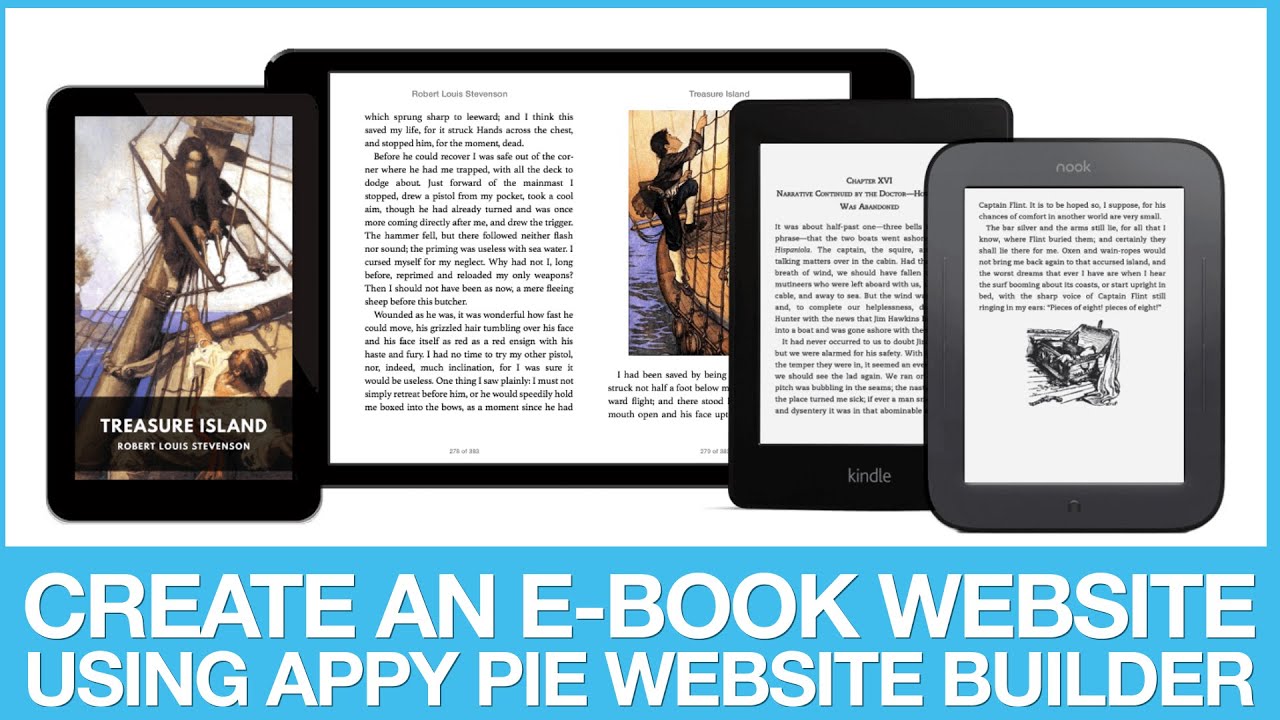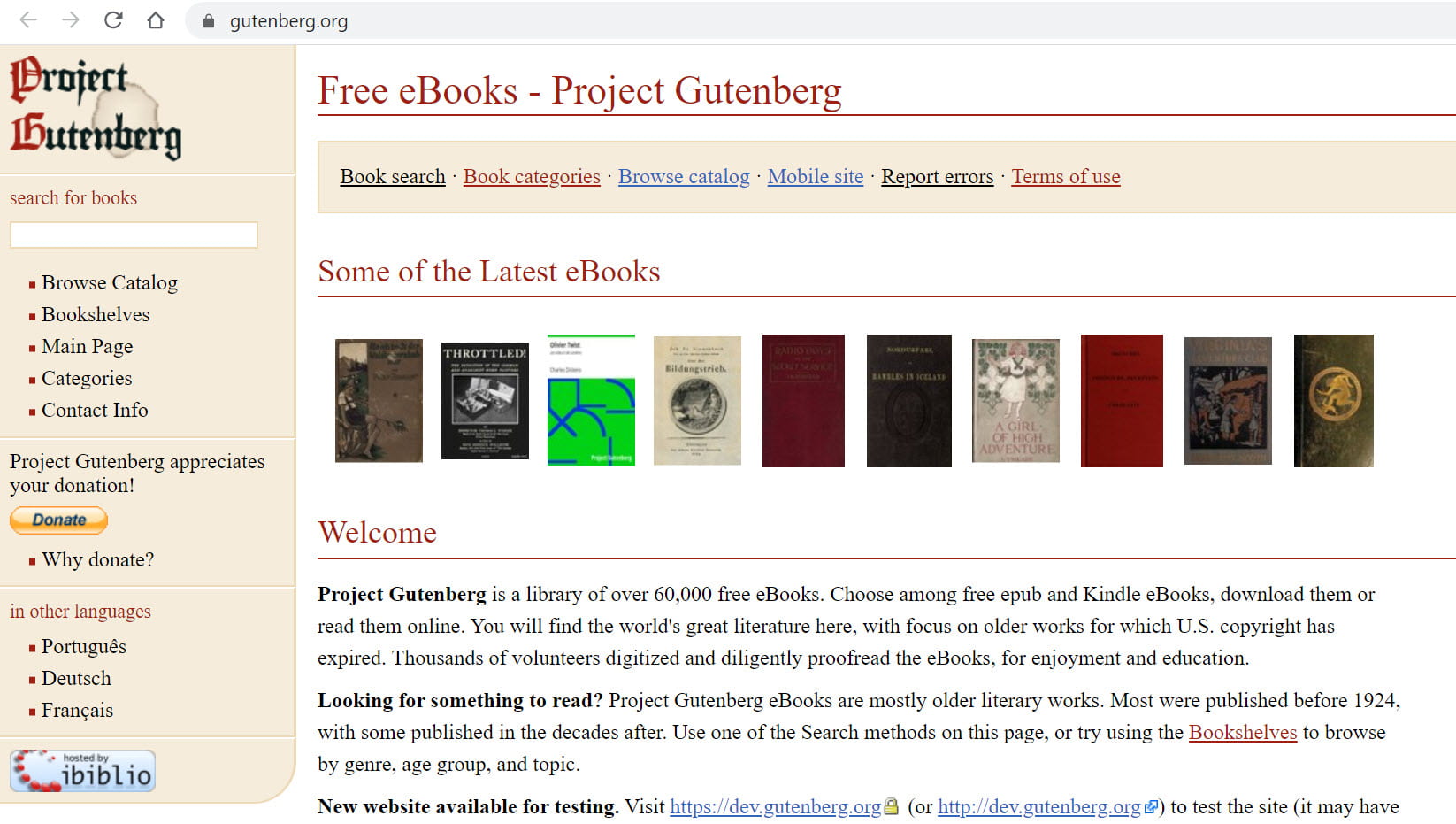Introduction
Welcome to the world of eBooks! In today’s digital age, more and more people are turning to eBooks for their reading pleasure. Whether you’re a writer, a publisher, or just a book lover looking to create your own eBook website, this guide is here to help you get started.
With the increasing popularity of self-publishing and the ease of accessing eBooks online, having a dedicated website to showcase and sell your eBooks can be a game-changer. It not only allows you to reach a wider audience but also provides a platform to establish your brand and connect with your readers directly.
Creating an eBook website may sound daunting, especially if you have little to no technical knowledge. However, with the right tools and guidance, setting up a website for your eBooks can be a rewarding and exciting experience. This step-by-step guide will walk you through the process, from selecting a platform to optimizing your website for search engines.
Throughout this guide, we will primarily focus on using WordPress as the platform for building your eBook website. WordPress is a user-friendly content management system that powers millions of websites around the world. Its versatility, customizability, and extensive plugin support make it an ideal choice for creating and managing an eBook website.
Whether you’re an aspiring author ready to share your stories with the world or a publisher aiming to showcase your catalog in a digital format, this guide will provide you with all the information you need to create a professional and visually appealing eBook website.
So, let’s dive in and get started on the exciting journey of creating your own eBook website!
Step 1: Choose a Platform
The first step in creating your eBook website is to choose a platform that will serve as the foundation for your website. There are several options available, but for the purpose of this guide, we will focus on using WordPress.
WordPress is a popular and highly customizable platform that powers a large percentage of websites on the internet. It offers a vast library of themes and plugins that will allow you to create a unique and functional website without requiring extensive coding knowledge.
To get started, you’ll need to decide whether you want to use WordPress.com or self-hosted WordPress. WordPress.com is a hosted platform where your website will be hosted on their servers, while self-hosted WordPress requires you to have your own domain name and web hosting.
If you’re just starting out and want a hassle-free setup, WordPress.com may be the better option for you. It offers a free plan with limitations on customization and monetization, but you can upgrade to a paid plan for more flexibility.
On the other hand, if you want complete control over your website and the ability to monetize it fully, self-hosted WordPress is the way to go. You’ll need to purchase a domain name (e.g., yourwebsite.com) and web hosting from a reputable provider. There are many hosting companies to choose from, so be sure to do your research and select one that offers reliable service and good customer support.
Once you have your hosting account set up, you can install WordPress with just a few clicks using the one-click installer provided by your hosting provider. This will create a database for your website and install the WordPress files automatically.
With WordPress installed, you’ll have access to the WordPress dashboard, where you can manage your site’s content, appearance, and functionality. From here, you can start customizing your eBook website and turn it into a platform that reflects your brand and engages your audience.
Choosing WordPress as your platform lays the groundwork for creating an effective and visually appealing eBook website. It offers a user-friendly interface, a vast range of themes and plugins, and a supportive community to assist you along the way.
Now that you’ve selected your platform, it’s time to move on to the next step: purchasing a domain name and hosting for your eBook website.
Step 2: Purchase a Domain and Hosting
Now that you’ve chosen WordPress as your platform, the next step is to purchase a domain name and web hosting for your eBook website. Your domain name is the web address that people will use to access your website (e.g., www.yourebookwebsite.com), while web hosting is the service that stores your website files and makes them accessible to visitors.
When it comes to selecting a domain name, it’s important to choose something that is memorable, relevant to your eBooks, and easy to spell and pronounce. You can register a domain name through a domain registrar such as GoDaddy, Namecheap, or Google Domains. These registrars provide a simple process for searching and registering available domain names.
When choosing a domain extension (.com, .net, .org, etc.), it’s generally recommended to go with .com if it’s available, as it is the most recognized and commonly used extension. However, if your desired domain name is not available with a .com extension, you can consider other options such as .net or .org.
Once you’ve secured a domain name, you’ll need to choose a web hosting provider. There are numerous hosting companies available, each with their own features and pricing plans. It’s essential to select a reliable hosting provider that offers good server performance, 24/7 technical support, and features that align with your website’s needs.
Some popular hosting providers that are known for their WordPress compatibility include Bluehost, SiteGround, and HostGator. These providers offer easy WordPress installation, excellent customer support, and reliable hosting services.
When selecting a hosting plan, consider factors such as storage space, bandwidth, and website scalability. It’s important to choose a plan that can accommodate the size and traffic of your eBook website without experiencing performance issues.
Once you’ve chosen a hosting provider and plan, proceed to complete the registration process. You’ll be prompted to enter your domain name, select additional features or add-ons if desired, and provide billing information for payment.
After purchasing your hosting plan, you will receive an email with login details for your hosting account. These credentials will allow you to access your hosting control panel, where you can manage your website files, set up databases, and install WordPress.
Congratulations! You have successfully purchased a domain name and hosting for your eBook website. With these essentials in place, you’re ready to move on to the next step: installing and setting up WordPress.
Step 3: Install and Set Up WordPress
Now that you have your domain name and hosting sorted, it’s time to install and set up WordPress for your eBook website. WordPress makes this process incredibly easy, even for beginners.
Most hosting providers offer a one-click WordPress installation feature, which simplifies the process significantly. To get started, log in to your hosting account and locate the control panel or dashboard. Look for a section dedicated to website management or installations, where you’ll find the option to install WordPress.
Click on the WordPress installation button, and you’ll be prompted to provide some basic information, such as your website name, admin username, password, and email address. Once you’ve filled in these details, click on the “Install” or “Submit” button to begin the installation process.
The installation process usually takes just a few minutes, and once completed, you’ll receive a confirmation message. From there, you can access your WordPress dashboard by entering your website’s URL followed by “/wp-admin” (e.g., www.yourebookwebsite.com/wp-admin).
Upon logging in to your WordPress dashboard for the first time, you’ll be greeted with a clean and intuitive interface. Take a moment to familiarize yourself with the various sections and options available.
Now, it’s time to customize your eBook website’s appearance and functionality. WordPress offers a wide range of professionally designed themes that you can choose from. These themes allow you to change the look and layout of your website without any coding required.
To install a theme, navigate to the “Appearance” section in your WordPress dashboard and click on “Themes.” From there, you can browse through the available free themes or upload a premium theme if you’ve purchased one. Once you’ve found a theme that matches your vision, click on the “Install” button, followed by “Activate” to apply it to your website.
With your theme in place, you can further customize it by accessing the theme settings or using the built-in WordPress Customizer. In the Customizer, you can modify elements such as the site title, logo, colors, fonts, and layout to match your brand and style preferences.
Additionally, you can enhance your website’s functionality by installing plugins. WordPress plugins are like add-ons that extend the features and capabilities of your website. Popular plugins for eBook websites include WooCommerce for setting up an online store, Yoast SEO for search engine optimization, and Contact Form 7 for adding contact forms.
To install a plugin, go to the “Plugins” section in your WordPress dashboard and click on “Add New.” From there, you can search for specific plugins by name or explore different categories and popular plugins. Once you find a plugin, click on “Install Now,” and then “Activate” to enable it on your website.
By installing a theme and plugins, you have successfully set up the foundation of your eBook website. Next, we’ll dive into customizing and designing the necessary pages for your site.
Step 4: Choose and Customize a Theme
Selecting the right theme plays a crucial role in creating an attractive and functional eBook website. WordPress offers a wide variety of themes, both free and premium, that cater to different styles and purposes.
When choosing a theme for your eBook website, consider factors such as design aesthetics, responsiveness, customization options, and compatibility with plugins you plan to use. Look for a theme that aligns with your brand and showcases your eBooks in a visually engaging way.
To begin the theme selection process, log in to your WordPress dashboard and navigate to the “Appearance” tab. Click on “Themes” to access the available themes. You can filter the themes based on popularity, latest releases, or specific features.
Start exploring the collection of free themes provided by WordPress. These themes are generally well-designed and offer basic customization options. Preview different themes to see how they look and how they might fit your eBook website’s style. Once you’ve found a theme that catches your eye, click on “Install” and then “Activate” to apply it to your website.
If you’re looking for more advanced customization options and premium features, you can also explore the vast selection of premium themes offered by third-party marketplaces such as ThemeForest, Elegant Themes, and StudioPress. These themes often come with dedicated support and frequent updates.
Once you’ve selected a theme, it’s time to customize it to align with your brand. WordPress offers various customization options to make your eBook website unique. Access the “Customize” option under the “Appearance” tab to explore the available customization settings.
In the WordPress Customizer, you can modify elements such as the site identity (logo and title), colors, typography, header and footer settings, and more. Take advantage of these settings to create a consistent and visually appealing website that represents your eBook brand and captures the attention of your visitors.
Additionally, some themes offer advanced customization options through dedicated theme settings or page builder plugins. These tools provide more control over the layout, design, and functionality of your eBook website. Explore the capabilities of your chosen theme and utilize any additional customization features to make your website stand out.
Keep in mind that the goal is to create a visually appealing and user-friendly website, so avoid overcrowding your pages with excessive elements or complex designs. Opt for clean, intuitive layouts that highlight your eBooks and make it easy for visitors to navigate your site.
Remember, the customization possibilities are endless, so don’t hesitate to experiment and make adjustments until you achieve the desired look and feel for your eBook website.
With your theme selected and customized, your eBook website is taking shape. In the next step, we will install essential plugins to enhance its functionality.
Step 5: Install Essential Plugins
Plugins are a key component of any WordPress website, and they play a crucial role in enhancing its functionality and adding new features. In this step, we will explore essential plugins that are beneficial for your eBook website.
One of the essential plugins to consider is a plugin for setting up an online store. If you plan to sell your eBooks directly from your website, a plugin like WooCommerce is highly recommended. WooCommerce is a powerful and popular eCommerce plugin that allows you to showcase and sell your eBooks with ease. It provides features such as product listing, shopping cart functionality, secure payment gateways, and inventory management.
Another important plugin to consider is a search engine optimization (SEO) plugin. SEO plays a vital role in improving your website’s visibility and ranking in search engine results. Yoast SEO is a popular plugin that helps you optimize your eBook website for search engines. It provides features such as XML sitemap generation, content analysis, meta tag optimization, and social media integration.
As an eBook author, it’s also beneficial to have a plugin for displaying your eBooks in an elegant and user-friendly manner. Easy Digital Downloads is a plugin designed specifically for selling digital products, including eBooks. It provides features like download delivery, customizable purchase buttons, customer management, and sales tracking.
Additionally, consider adding a caching plugin to improve your website’s speed and performance. WP Rocket and W3 Total Cache are two popular caching plugins that help reduce page load times, which is crucial for providing a positive user experience and better search engine rankings.
Contact Form 7 is another valuable plugin to include on your eBook website. This plugin allows you to create and manage custom contact forms, making it easy for readers and potential customers to get in touch with you. It provides options for fields, email notifications, form validation, and more.
Other plugins you may want to consider include social sharing plugins to encourage readers to share your eBooks on social media, security plugins to protect your website from malicious attacks, and analytics plugins to track website performance and visitor statistics.
To install a plugin, go to the “Plugins” section in your WordPress dashboard and click on “Add New.” From there, you can search for specific plugins by name or browse popular plugins in different categories. Click on “Install Now,” and then “Activate” to enable the plugin on your eBook website.
Remember, while plugins can greatly enhance your website’s functionality, it’s important not to overdo it. Having too many plugins can slow down your website or cause conflicts. Only install plugins that are necessary for your eBook website’s specific needs and regularly update them to ensure compatibility with the latest version of WordPress.
With these essential plugins installed and activated, your eBook website is one step closer to becoming a fully functional and feature-rich platform. In the next step, we will focus on creating the necessary pages for your eBook website.
Step 6: Create Necessary Pages
Creating the necessary pages for your eBook website is an important step in providing valuable information to your visitors and showcasing your eBooks effectively. In this step, we will focus on the key pages that every eBook website should have.
The first and most essential page is the homepage. This is where visitors land when they first enter your website, and it should make a strong impression. The homepage should provide a brief overview of your eBooks, showcase featured or new releases, and include clear navigation to other important sections of your website.
Next, create a dedicated page for each eBook you have published. These individual eBook pages should include a captivating book cover image, a description of the book, an excerpt or sample chapter, and a call-to-action button or link to purchase or download the eBook. Consider adding testimonials or reviews from readers to build trust and credibility.
In addition to the homepage and individual eBook pages, you should create an “About” page to introduce yourself as the author or provide information about your publishing company. This page helps readers connect with you on a personal level and learn more about your background and writing journey.
A “Contact” page is also crucial, as it provides a way for visitors to get in touch with you. Include a contact form or provide your contact information, such as an email address or social media links, so that readers can easily reach out with any inquiries or feedback.
Consider adding an “FAQ” page to address common questions or concerns that visitors may have. This page can cover topics like eBook formats, purchasing and downloading instructions, or any specific details about your eBooks that readers may want to know.
Lastly, if you plan to blog about writing tips, industry news, or book recommendations, create a “Blog” page to showcase your latest blog posts. Blogging can help attract organic traffic, engage your audience, and establish your authority as an author in your niche.
When creating these pages, keep in mind the importance of visual appeal and user experience. Use high-quality images, clear and concise text, and a consistent design throughout your website. Organize your pages in a logical and intuitive manner, making it easy for visitors to navigate and find the information they are looking for.
Once your pages are created, be sure to add them to your website’s navigation menu. This allows visitors to access the different pages easily and ensures a smooth browsing experience.
Remember, your eBook website is a representation of your brand and your eBooks. Take the time to optimize each page with relevant keywords, meta tags, and headings to improve search engine visibility and attract organic traffic.
Now that you have your necessary pages in place, it’s time to focus on designing an engaging and visually appealing homepage for your eBook website in the next step.
Step 7: Design Your Website’s Homepage
Your website’s homepage is the first impression that visitors will have of your eBook website, so it’s important to design it in a way that captures their attention and encourages them to explore further. In this step, we will focus on designing a visually appealing and engaging homepage for your eBook website.
Start by thinking about the main message you want to convey on your homepage. What is the central theme or purpose of your eBook website? Is it to showcase your latest releases, promote a particular eBook, or create a sense of intrigue? This will guide you in creating a compelling headline or tagline that immediately grabs the attention of your visitors.
Consider using high-quality and eye-catching images that represent the essence of your eBooks or the emotions they evoke. This can be a book cover image, a captivating background image, or a carousel of images showcasing your featured eBooks. Remember, visuals play a crucial role in capturing the interest of visitors and conveying the value of your eBooks.
Below the headline and main image(s), provide a brief overview of your eBooks or your unique selling proposition. Use concise and engaging text to entice visitors to explore further. Consider highlighting key benefits or features of your eBooks, such as genres, special themes, or any awards or recognition they have received.
Integrate clear and prominent calls-to-action (CTAs) on your homepage to guide visitors towards the next step you want them to take. This can be a “Buy Now” button, a “Download Free Sample” link, or a “Learn More” CTA that takes them to individual eBook pages. Make sure the CTAs are visually distinct and strategically placed to encourage action.
Another important element to include on your homepage is social proof, such as testimonials or reviews from satisfied readers or industry experts. This helps build trust and credibility, convincing visitors that your eBooks are worth exploring and purchasing. Include quotes, star ratings, or snippets of positive feedback to validate the quality of your work.
Consider adding clear navigation menus or sections on your homepage to make it easy for visitors to explore different areas of your website. This can include links to individual eBook pages, your blog, an “About” page, or a “Contact” page. Make the navigation intuitive and logical, ensuring that visitors can find the information they need with ease.
Lastly, pay attention to the overall layout and visual coherence of your homepage. Use a grid-based structure to organize different sections, ensuring that everything is aligned and visually pleasing. Choose fonts, colors, and other design elements that represent your brand and create a harmonious overall look. Avoid clutter and excessive text, as simplicity and clarity go a long way in creating a positive user experience.
Regularly review and update your homepage to keep it fresh and dynamic. Consider adding sections for featured eBooks, special promotions, or upcoming releases to keep visitors engaged and encourage repeat visits.
By designing an engaging and visually appealing homepage, you’ll make a powerful impression on visitors and entice them to explore further into your eBook website. In the next step, we’ll focus on setting up an eBook store to streamline the purchasing process for your readers.
Step 8: Set Up an eBook Store
Setting up an eBook store on your website provides a convenient and streamlined way for readers to purchase and download your eBooks. In this step, we will guide you through the process of setting up an eBook store that is user-friendly and secure.
The first step is to install and activate an eCommerce plugin that is specifically designed for selling digital products. WooCommerce is a popular and robust choice for setting up an online store on WordPress. Install the WooCommerce plugin from the WordPress dashboard by navigating to the “Plugins” section and clicking on “Add New.” Search for “WooCommerce,” click “Install Now,” and then “Activate.”
After activating the plugin, you’ll be guided through a setup wizard that helps you configure important store settings such as currency, payment methods, shipping options, and tax calculations. Follow the prompts and provide the necessary information to tailor the store to your specific requirements.
Next, upload your eBook files to the media library. Ensure that your eBooks are properly formatted and saved in a compatible file format, such as PDF, EPUB, or MOBI. Once uploaded, you can associate the eBook files with the corresponding product in your store.
Create a product page for each eBook in your store. Include a captivating book cover image, a descriptive title, an engaging book description, and any additional information, such as author bio or genre. Set the price and select the appropriate downloadable files for customers to access upon purchase.
Configure shipping settings if you offer physical copies of your books. Choose the appropriate shipping methods and rates and set up any necessary shipping zones.
Customize the appearance of your eBook store by accessing the WooCommerce settings. You can modify the layout, colors, typography, and other visual elements to match the overall design of your website and enhance the user experience.
To ensure a secure payment process, integrate SSL (Secure Sockets Layer) encryption on your website. This helps protect your customers’ personal and financial information. Many hosting providers offer SSL certificates that can be easily installed on your website.
Consider adding product reviews and ratings functionality to your eBook store. This provides social proof and helps potential customers make informed purchasing decisions. WooCommerce offers extensions or plugins that can integrate this feature seamlessly into your store.
Regularly update and maintain your eBook store by keeping the plugin, themes, and extensions up to date. Monitor inventory levels, manage orders, and provide robust customer support to ensure a smooth purchasing experience for your customers.
With the eBook store set up, your readers can easily browse, select, purchase, and download your eBooks directly from your website. In the next step, we will focus on creating individual eBook pages to showcase your books in more detail.
Step 9: Create Individual eBook Pages
Creating individual eBook pages allows you to showcase each book in more detail, providing potential readers with a comprehensive overview and enticing them to make a purchase. In this step, we will guide you through the process of creating engaging and informative individual eBook pages for your website.
Start by selecting a captivating cover image for each eBook. The cover image is the first thing that catches the reader’s eye and can greatly impact their interest in the book. Ensure that the cover accurately represents the content and genre of the eBook while being visually appealing.
Next, provide a compelling book description or summary on the individual eBook page. Craft a concise and engaging description that entices readers and gives them a glimpse into the story or knowledge they can expect to gain from the book. Be sure to highlight any unique selling points or features that differentiate your eBook from others in the same category.
To give readers a taste of the eBook, consider including an excerpt or sample chapter on the individual eBook page. This allows potential readers to get a feel for your writing style and the content of the book, helping them decide if it’s a good fit for their interests.
In addition to the book description, consider including more detailed information, such as the genre, target audience, release date, and any accolades or awards received. This provides readers with valuable information and helps them understand the value of your eBook.
If you have received positive reviews or testimonials for the eBook, showcase them on the individual page. This helps build trust and credibility, as potential readers can see that others have enjoyed and appreciated your work.
Include buttons or links on the individual eBook page that direct readers to purchase or download the eBook. These buttons should be prominently displayed and placed strategically to encourage conversions. If you have an online store set up, link the buttons to the corresponding product page in your eCommerce system.
Enhance the individual eBook page with visually appealing and captivating visuals. This may include additional images or graphics related to the eBook, such as author photos, illustrations, or relevant background images. Visual elements can further engage readers and create a visually pleasing browsing experience.
Don’t forget to optimize the individual eBook pages for search engines by including relevant keywords in the content, headings, and meta tags. This will increase the visibility of your eBooks in search engine results and attract organic traffic to your website.
Regularly update the individual eBook pages with any new information, such as additional editions or translations, book trailers, or upcoming events related to the eBook. Keeping the pages current and engaging shows readers that you are actively involved in promoting and supporting your eBooks.
By creating well-crafted and informative individual eBook pages, you provide potential readers with the necessary details and enticements to make a purchase. In the next step, we will focus on optimizing your eBook website for search engines.
Step 10: Optimize Your Website for SEO
Optimizing your eBook website for search engines is crucial to improve its visibility in search results and attract organic traffic. In this step, we will guide you through the process of optimizing your website for SEO.
Begin by conducting keyword research to identify the relevant and popular search terms related to your eBooks. Use keyword research tools like Google Keyword Planner or SEMrush to discover keywords that have a high search volume and low competition. Incorporate these keywords naturally into your website’s content, including page titles, headings, meta descriptions, and throughout your eBook descriptions and articles.
Ensure that your website’s structure is user-friendly and organized. Create clear and logical navigation menus that allow visitors to easily find the information they are looking for. Use descriptive labels for menu items and internal links to guide visitors and search engine crawlers through your website.
Optimize your page titles and meta descriptions. These elements appear in the search engine results and serve as a preview of the content on your eBook website. Craft compelling and concise titles and descriptions that include relevant keywords and encourage users to click on your website.
Optimize your website’s loading speed by minimizing file sizes, enabling caching, and optimizing image files. A fast-loading website provides a better user experience and is favored by search engines. Compress images without compromising quality, and consider using a caching plugin to improve the performance of your website.
Create unique and informative content that addresses the interests and needs of your target audience. Develop blog posts, articles, or resources related to your eBooks and optimize them with relevant keywords. Consistently publishing high-quality content can boost your website’s authority, attract backlinks, and increase organic traffic.
Optimize your images by using descriptive alt tags that serve as alternative text descriptions. This helps search engines understand the content of your images and improves accessibility for users with disabilities. Use descriptive filenames for your images as well.
Make use of internal and external linking. Internal links help visitors navigate your website, discover related content, and allow search engines to crawl your website more effectively. External links to authoritative and relevant websites can also improve your website’s credibility and provide additional value to your readers.
Utilize social media to promote your eBooks and drive traffic to your website. Share snippets, excerpts, or engaging visuals from your eBooks on platforms like Facebook, Instagram, Twitter, and LinkedIn. Encourage readers to share your content, which can increase visibility and attract potential readers.
Create a sitemap for your eBook website and submit it to search engines like Google and Bing. This helps search engines crawl and index your pages more efficiently, ensuring that your website is properly represented in search results.
Regularly monitor and analyze your website’s performance using SEO tools like Google Analytics or Moz. These tools provide valuable insights into visitor behavior, traffic sources, and keyword performance. Identify areas for improvement and make necessary adjustments to optimize your website further.
Remember that SEO is an ongoing process, and it takes time to see results. Stay consistent with your optimization efforts, continue to produce high-quality content, and monitor your website’s performance to ensure your eBook website remains optimized for search engines.
With your eBook website optimized for SEO, you can increase its visibility, attract more organic traffic, and reach a wider audience of potential readers. In the final step, we will focus on promoting your eBook website to increase its exposure.
Step 11: Promote Your eBook Website
Now that your eBook website is up and running, it’s time to promote it and get the word out to potential readers. In this step, we will explore various strategies and channels to effectively promote your eBook website and increase its exposure.
1. Social Media Promotion: Leverage the power of social media platforms like Facebook, Twitter, Instagram, and LinkedIn to promote your eBooks and engage with your audience. Create compelling posts, share excerpts or sneak peeks, run contests or giveaways, and interact with your followers to build a community around your eBooks.
2. Guest Blogging: Write guest posts for popular blogs in your niche or industry. This allows you to tap into existing audiences and establish yourself as an authoritative voice. Include a link back to your eBook website in the author bio or within the content to drive traffic and attract potential readers.
3. Email Marketing: Build an email list of interested readers and use email marketing campaigns to share updates, new releases, exclusive offers, and valuable content related to your eBooks. Offer a signup form on your website to encourage visitors to join your mailing list.
4. Content Marketing: Create valuable and informative content like blog posts, articles, or infographics that are relevant to your eBooks. Publish this content on your website’s blog or share it on other platforms. This helps establish you as an authority in your field and attracts readers to your website.
5. Collaboration with Influencers: Collaborate with influencers or bloggers in your niche who have a substantial following. They can review or promote your eBooks to their audience, giving you access to a wider reach and potentially boosting your sales and website traffic.
6. Online Advertising: Consider running targeted online advertising campaigns, such as Google Ads or social media ads, to reach potential readers who may be interested in your eBooks. Set a budget, define your target audience, and create compelling ad copy that encourages clicks and conversions.
7. Book Review Sites: Submit your eBooks to reputable book review sites or online communities. Positive reviews can generate interest and credibility, attracting more readers to your eBook website.
8. Participate in Online Communities: Engage in online forums, groups, or communities related to your eBook’s genre or topic. Provide valuable insights and participate in discussions, building relationships with potential readers and establishing yourself as an active and knowledgeable member of the community.
9. Utilize SEO Strategies: Continue optimizing your website for search engines by incorporating relevant keywords, creating high-quality content, obtaining backlinks from reputable websites, and monitoring your website’s SEO performance. This helps improve your ranking in search results, driving organic traffic to your eBook website.
10. Attend Virtual Events or Webinars: Take advantage of online events, webinars, or virtual book fairs to showcase your eBooks and interact with potential readers and industry professionals. Engage in discussions, give presentations or readings, and provide exclusive offers to attendees.
Remember, promoting your eBook website requires consistent effort and ongoing marketing strategies. Experiment with different promotional channels and analyze the results to determine what works best for your target audience. With effective promotion, you can reach more readers, increase eBook sales, and achieve greater success with your eBook website.
Conclusion
Congratulations on successfully creating your own eBook website! In this comprehensive guide, we have walked you through the step-by-step process of setting up and optimizing an eBook website that showcases your eBooks to the world. From choosing a platform and purchasing a domain and hosting, to designing appealing pages and implementing essential plugins, you have learned the key elements necessary to create a professional and functional eBook website.
By following the steps outlined in this guide, you have laid a strong foundation for your eBook website’s success. Remember to regularly update and maintain your website by adding new eBooks, creating engaging content, and staying up to date with the latest industry trends and technologies.
Additionally, don’t overlook the importance of promoting your eBook website. Take advantage of social media platforms, email marketing, content creation, collaborations, and online advertising to reach a wider audience and generate interest in your eBooks. It’s crucial to continuously promote your website and engage with your target audience to build a loyal reader base.
Lastly, always monitor your website’s performance, analyze the data, and make necessary adjustments to improve user experience, increase visibility, and enhance conversion rates. Stay updated with SEO best practices to keep your website optimized for search engines and attract organic traffic.
While it may require ongoing effort and dedication, creating and maintaining an eBook website opens up exciting opportunities for self-publishing authors, publishers, and book lovers alike. It provides a platform to showcase your talents, connect with readers, and share your passion for literature.
Remember, the key to success lies in delivering high-quality content, engaging your audience, and building a strong brand presence. Stay true to your unique voice and vision, and continue to refine and improve your eBook website over time.
Best of luck on your journey in the world of eBooks and may your website flourish and attract readers from across the globe!

























